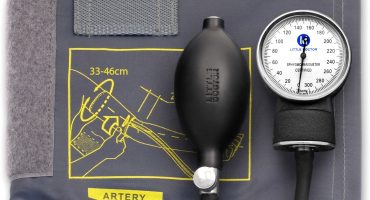People over 40 have prerequisites for the development of glaucoma and other diseases that provoke high eye pressure. Anyone who has crossed the age line needs to prevent and prevent various deviations in a preventive manner. Why it is necessary to undergo an examination once a year and check the intraocular pressure. Ophthalmologists use the Maklakov tonometer for this.
Why control intraocular pressure

Modern devices for measuring eye pressure
Frequent changes in eye pressure, as a rule, go unnoticed. Signs that occur with the development of the problem, such as headache and redness of the eyes, are attributed to overwork and fatigue. Often, eye pressure is measured in two cases. The first is a routine examination for glaucoma. The list includes people from risk groups: over 40 years old and those who have a hereditary predisposition. But it is necessary to be examined regularly by everyone, preferably with the same method.
The second is the appearance of signs of jumps in intraocular pressure. For example, loss of vision, flies, or blurred eyes. Pain in the temporal part of the head and eyes, redness of the eyeball also refers to the prerequisites for a mandatory examination.

Glaucoma diagnostics with modern equipment
Jumps in intraocular pressure are often symptoms of dangerous diseases:
- tumor overgrowth;
- inflammatory pathologies;
- mechanical injuries occurred.
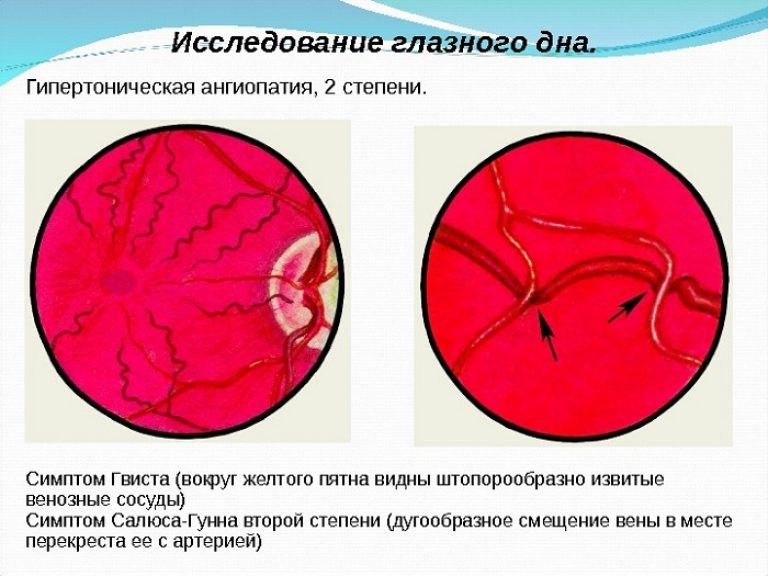
Pathologies accompanied by increased intraocular pressure
Therefore, they should be diagnosed in a timely manner.
High pressure in the absence of timely therapy can lead to atrophy of retinal cells, often there is a metabolic disorder in the organ of vision. Overestimated IOPs often lead to glaucoma.
Lower IOP values can also cause many troubles. It promotes the expansion of venous vessels in the eyeball and stagnation of blood in it. In this case, metabolic processes in the eye are disrupted, and changes occur: clouding of the cornea and vitreous body of the eye, as well as a decrease in the size of the eye and a drop in vision. With any change in intraocular pressure, if pathology is not treated, blindness may occur. That is why intraocular pressure and control of its indicators are of great importance.
How to measure IOP using the Maklakov method
First, an anesthetic is instilled into the eyes, and then the device itself is placed in the center of the eyeball. The Maklakov tonometer for studying intraocular pressure looks like a small cylinder made of metal weighing only 10 g. Frosted glasses with a diameter of 1 cm are located at the two ends of the cylinder. A lead rod is installed inside it. Glasses are treated with alcohol and a thin layer of paint prepared from glycerin, collargol and purified water is applied.
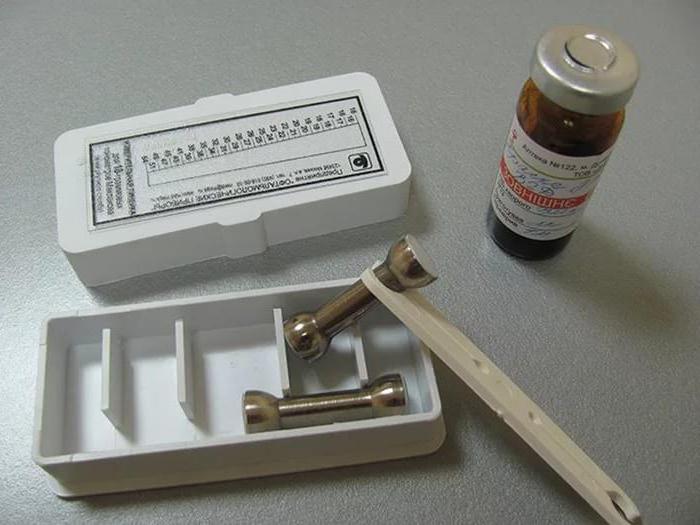
Maklakov tonometer for measuring intraocular pressure
The man lies on his back, face up, slightly raising his chin. After 5 minutes have elapsed since the instillation of the anesthetic, the measurement procedure itself begins.The doctor is located at the head of the patient, with the fingers of one hand he spreads the eyelids of the patient, and with the other hand sets the tonometer directly on the center of the cornea.
The principle of operation is as follows:
- the load, that is, the device, presses on the cornea, which makes the paint stain the cornea;
- then the weight must be quickly removed and imprinted on frosted paper with frosted glass;
- these actions are carried out alternately on both eyes, then an antibacterial agent is instilled into them so as not to cause infection.

Inspection with a Maklakov tonometer
Then the data must be analyzed and the survey results obtained. When the tonometer falls on the cornea, then the paint is washed off with a tear at this place, so the print on the paper is obtained in the form of a ring. The diameter of the light circle corresponds to the stage of flattening of the cornea, a little is removed at high pressure, and the area of the light print will be less.
Next, measure the diameter of the light circle with a transparent ruler. To eliminate the distortion of the results, it must be put with the scale down. You can view the readings through a binocular magnifier, and the scale gives pressure readings immediately in millimeters of mercury. The measurement standard for this method is considered to be a segment of 18-26 mm RT. Art.
Device design and quality characteristics
Measurement of intraocular pressure according to Maklakov is performed by a special tonometer. The device is equipped with tools for a full session for one patient, it includes:
- Two weights having a cylindrical shape with flat ends.
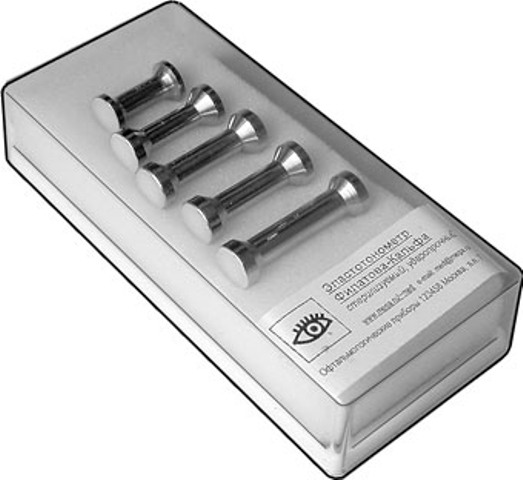
Weights with different weights
- A holder for them, required for securing tools during operation.
- Three rulers for measuring results.
- Case for tools.
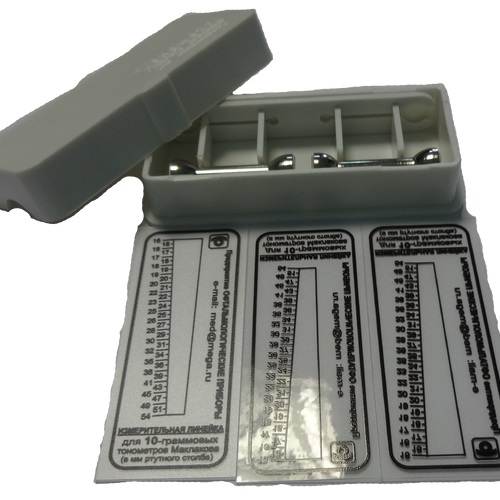
Maklakov tonometer set with three rulers
Weights have a lead weight inside. You need to hold them with special holders, you do not need to create unnecessary pressure on the cornea.
It should be noted that Maklakov tonometers are still used everywhere, because they measure with an accuracy of almost 100%. The downside of this device is the risk of introducing an infection to the patient during the study and the likelihood of an allergic reaction to the anesthetic. The accuracy of the measurement with this device greatly depends on the qualifications and skills of the specialist who conducts the measurements. The movements in the measurement should be worked out to automaticity, then the accuracy will be guaranteed.

The procedure for measuring intraocular pressure with a Maklakov tonometer
Safety in use is due primarily to sterility. After each use, the tonometer undergoes sterilization and is then stored in a sterile case. Damage to the eyeball is ruled out because the weights are lightweight. But here the human factor plays an important role: the low qualification of the doctor or the patient’s nervousness can cause eye injury. Also, before measuring, you need to check the end of the weight at the time of damage, they can injure the eye.
How is Maklakov tonometers processed?
The device is disinfected after each use and is stored in a sterile container until next use. The processing order is presented in the following sequence:
- Immediately after use, it is required to clean the paint from the weights and disassemble the device. Wipe the holder with an appropriate disinfectant solution.
- Put weights in a container with disinfectant and leave them for half an hour.
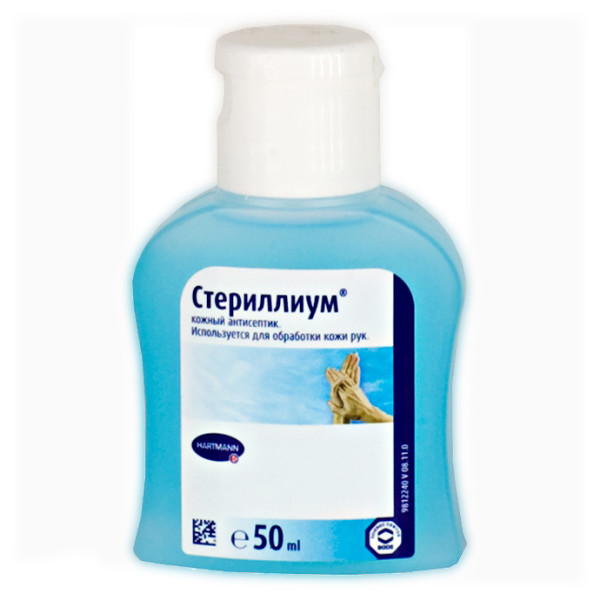
One of the disinfecting solutions used
- This is followed by rinsing in running water until the solution is completely washed off, otherwise it may get on the shell of the eye.
- Then follows drying for an hour on a napkin.
- Be sure to store in a sterile case for no more than 3 days. If the device is not used, then you need to re-disinfect.

Maklakov tonometer with a special capacity for disinfection
Tonometer disinfection is carried out with special solutions.But sterilization - in special cases, if a patient was examined with suspected inflammation or the threat of a viral lesion of the conjunctiva. Sterilization is carried out by boiling in a 2% soda solution, the device should boil for half an hour.
IOP measurement using this method is a simple and accurate diagnostic method. It was developed a long time ago, but it has not lost its relevance in modern medicine. Accurate indicators are his plus, in addition, the method can be used both for adults and children, starting from school age.



